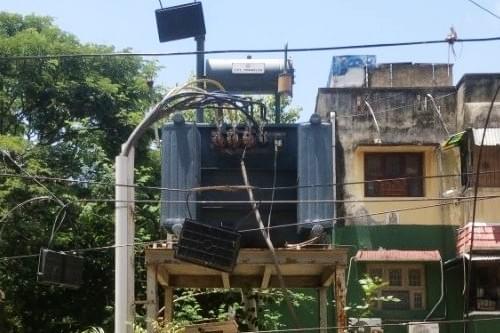Economy
Quiet Flows Reforms In Tamil Nadu Power Sector, But Much More Is To Be Done
M R Subramani
Jul 03, 2018, 04:33 PM | Updated 04:33 PM IST
Save & read from anywhere!
Bookmark stories for easy access on any device or the Swarajya app.


Quietly, the Tamil Nadu government has been going through with reforms in the power sector. These reforms are being helped by its initiative to produce more green or renewable sources of energy.
Tamil Nadu Electricity Minister P Thangamani told the State Assembly on 1 June that Tamil Nadu is the leading state in green energy initiatives with an installed capacity of 11,113 mW till 31 March this year. Last fiscal, the Tamil Nadu Generation and Distribution Corporation (Tangedco) harnessed 13,000 million units of wind energy and 2,905 million units of solar energy.
“Tamil Nadu has been making progress in reforming and transitioning its electricity system. TANGEDCO has narrowed its losses, and with further renewables coming on-stream, this should provide an opportunity to replace expensive imported and non-mine mouth coal fired power generation for lower cost, more sustainable renewable energy,” says Tim Burkley, Director of Energy Finance Studies, Institute for Energy Economics and Financial Analysis (IEEFA), Australia.

Burkley’s statement is supported by Tangedco cutting its losses in 2016-17 fiscal to Rs 3,873 crore from a whopping Rs 13,985 in 2013-14, down by over 70 per cent.
The focus on renewable energy has drastically brought down the power purchase cost of Tangedco. It has also enabled Tamil Nadu to become a power-surplus state with an ability to export power to other states. The costs are likely to drop further.
An entrepreneur, not wishing to be identified, told Swarajya that Tamil Nadu gained from entrepreneurs’ initiatives to set up windmills two decades ago to avail of depreciation benefits. “Many textile firms set up these windmills to take advantage of the benefits,” the entrepreneur said.
Tamil Nadu will be adding more to its wind power generating capacity with the Power Grid Corporation adding 800 MW besides Tangedco increasing it by another 1,500 MW.
On the solar power front, though a late starter, Tamil Nadu has installed 1,800 MW capacity and Tangedco has plans to add another 1,500 MW. With wind power tariff dropping below that of thermal power, Tamil Nadu is evacuating power at around Rs 3 per unit – a better option instead of burning non-renewable sources like coals.
Two things have given a fresh lease of life to the power sector in Tamil Nadu, especially on the renewables front. One is the Narendra Modi government’s decision to encourage production of renewable energy, especially solar. Two, the decision of the Tamil Nadu government to sign the Ujwal Discom Assurance Yojana (UDAY), paving the way for restructuring the electricity board’s finances.
“Tamil Nadu was reluctant to sign the UDAY scheme. But once it signed it, the results are there for all to see,” said the entrepreneur, pointing to the state being no more power deficit and selling power to other states.
The UDAY scheme has been successful overall, with India’s distribution companies (discom) losses reducing each year since 2015, says Burkley. “However, some states like TN joined later, so still have some way to go. Also, UDAY success has not been uniform. Some states have failed to deliver on their targets and have gone backwards on some measures,” he says.
Karnataka has been successful in its electricity system transformation, surpassing Tamil Nadu to become the leading state for renewables in India in 2018. But Karnataka’s five discoms have seen reduced AT&C (commercial) losses and significant investment in renewables; they have seen discom losses expand in 2017-18 fiscal, he says.
“The power situation in Tamil Nadu is a lot better now from the consumer point of view. We don’t face any major power failure and in a city like Chennai, we have no complaints,” says Aubrey Daniels, Regional Director, American Chambers of Commerce, India.
Agreeing that reforms are taking place in Tamil Nadu’s power sector, Tamil Nadu Electricity Board Janata Union President S Elango says much more needs to be done.
“The focus is shifting to quality of power distributed. Old transformers have given way to new, efficient ones. New sub-stations have come up to improve supply,” says Daniels.

The other aspect of improving supply is laying of underground cables, especially in Chennai. Tamil Nadu government plans to spend over Rs 2,500 crore for this.
“Most of Chennai has underground power cables. But there’s a lot to do. The plan should be extended to other cities in the state at least,” says Elango.
IEEFA, in its report on Tamil Nadu power reforms, finds Tamil Nadu’s plans to treble thermal power capacity “unrealistic”. This would force the state to be reliant on liquefied natural gas or coal sourced from abroad, making production costs prohibitive at Rs 5-6 per kWh. Against this, renewable power can be produced between Rs 2 per kWh and Rs 4 per kWh.
“Coal import is one issue that is dogging Tamil Nadu power sector for too long. This leads to corruption and often coal is imported due to low quality of indigenous commodity,” says Daniels.
But Elango says import decisions are made at the top level and corruption is an issue affecting the economics. “The state is importing coal from Australia or Indonesia that has low ash content. Coal from Indian mines have higher ash content and this is being shown as a reason for imports,” he says.
Industry watchers say that, be it any government, coal imports are a source of corruption and raise revenue outgo for the state.
“The Directorate Revenue Intelligence has been investigating a reported $5 billion imported coal from Indonesia scam that has been clearly instrumental in increasing energy poverty in India. For India’s own credibility domestically as well as in international markets, it is really important that those parties involved in tax evasion, theft and bribery be held to account,” said Burkley.
Daniels says that Tamil Nadu government will have to carry out more reforms in transmission and distribution (T&D). “Free power supply and subsidies will have to go or at least metered to bring them down. Subsidies have to be controlled,” he says.
T&D reform is critical, says Burkely, adding that without a successful discom and T&D system reform, India’s electricity system will continue to be a major impediment to sustained strong economic growth for India, both directly and because of the massive negative impost of the thermal power generation and discom sectors are imposing on the Indian banking system.”
Discom and T&D reform needs to succeed, as does the Reserve Bank of India efforts to resolve the massive non-performing assets in the thermal power sector. “The best way to reduce this problem is to both hold promoters responsible and to stop sinking more good money after bad trying to bail out stranded thermal projects that realistically need to be written off and cancelled,” said Burkley.
Last fiscal, Rs 7,724 crore was spent on subsidies to agriculture sector and hut dwellers, according to this report. The All India Anna Dravida Munnetra Kazhagam had in its manifesto for 2016 May assembly elections, promised free power supply up to 100 units to home-dwellers. On regaining power in 2016, late J Jayalalithaa had signed this free power supply among the first files. Free electricity makes up 15 per cent of the power consumed in the state, forcing commercial and industrial sector, that make up 46 per cent of the demand, to cough up a higher tariff.
“The subsidised power supply to the agricultural sector is a political reality of Tamil Nadu and India generally. India has many people living in poverty, and that reality is unlikely to be fully resolved any time soon. I am all for providing a social safety net,” says Burkely, adding that the trouble is that politicians throughout India are using subsidised electricity as a vote-buying exercise. “But failure to properly fund and account for this massive subsidy leaves TANGEDCO the out-of-pocket intermediary left carrying the cost,” he says, adding that solving political patronage and vote-buying is a complex and difficult process, be it Australia or Tamil Nadu.
Despite the progressive reforms, Tamil Nadu still relies on thermal power that makes up 45 per cent of the capacity. In 2016, according to IEEFA, 62 per cent of the capacity was utilised, higher than other sources. Renewables make up 35 per cent of power generation capacity, but, unfortunately, only 18 per cent of it was utilised.
The view then, across the state, is that Tamil Nadu power sector is looking up with the reforms being carried out, especially on the renewable side. But the state has to traverse some more distance to improve the viability of its electricity department by ending subsidy and cutting T&D losses.
The way forward, according to Burkley, is for Tamil Nadu to upgrade the T&D system to cut the unsustainable losses and also by addressing issues of power theft and wastage.
M.R. Subramani is Executive Editor, Swarajya. He tweets @mrsubramani




